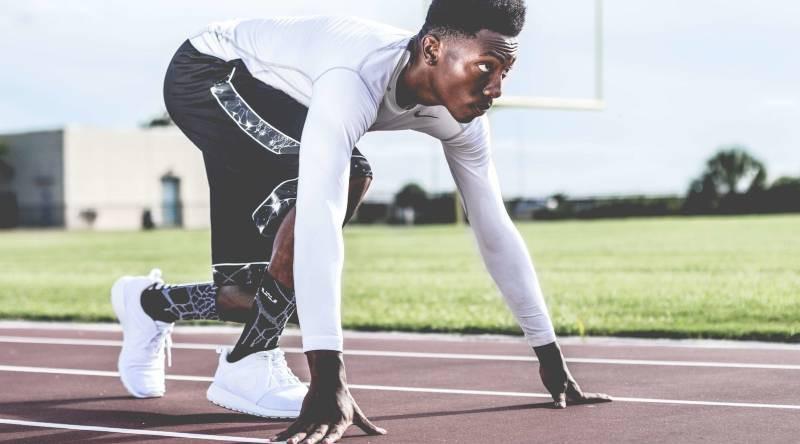Why did the chicken sprint to the other side of the road? To get bigger legs, of course! But seriously, if you’ve ever wondered whether sprinting can actually make your legs bigger, you’re not alone. In this blog post, we’ll delve into the science behind sprinting and leg size to find out whether this popular form of exercise can really help you achieve your #legday goals.

Ten Benefits of Sprinting
Sprinting is a form of high-intensity cardiovascular exercise that can offer numerous benefits to people of all fitness levels. Here are just a few of the potential benefits of sprinting:
- Improved cardiovascular health: Sprinting is an intense cardiovascular workout that can help improve your overall cardiovascular health by increasing your heart and lung function.
- Increased fat loss: Because sprinting is a high-intensity exercise, it can burn a significant number of calories in a short amount of time, making it an effective way to lose fat and improve your overall body composition.
- Enhanced muscle development: Sprinting can lead to muscle hypertrophy, or the increase in size of muscle cells, particularly in the lower body. It can also increase muscle strength and power.
- Improved athletic performance: Sprinting can improve your speed, agility, and power, making it a great exercise for athletes looking to improve their sports performance.
- Enhanced mental health: Like all forms of exercise, sprinting can improve your mood and reduce stress and anxiety.
- Increased bone density: Sprinting has been shown to increase bone density, which can help prevent osteoporosis and other bone-related conditions.
- Improved coordination and balance: Sprinting requires coordination and balance, especially when changing direction quickly. As you become more proficient at sprinting, you may notice improvements in your overall coordination and balance.
- Enhanced flexibility: Sprinting involves a range of motion that can help improve your flexibility and mobility, especially if your warm up includes dynamic stretchung and your cool-down includes static stretching.
- Greater enjoyment: Many people find sprinting to be a fun and enjoyable form of exercise, especially when done in a group setting or with a partner.
- Increased socialization: Sprinting can be a great way to meet new people and socialize, especially if you join a running group or participate in sprinting events.
==> Incorporate sprinting in your workouts now for stupendous gains
How to Incorporate Sprinting into Your Workout Routine
If you’re interested in incorporating sprinting into your workout routine, here are a few things to consider:
- Early morning sprints: One option is to do your sprints first thing in the morning, before you start your day. This can be a great way to get your heart rate up and boost your energy levels for the day ahead. Just be sure to warm up properly before starting your sprints to reduce the risk of injury.
- Incorporating sprints into your bodybuilding split routine: If you follow a bodybuilding split routine, you may want to consider incorporating sprints on days that are not focused on leg training. For example, you could do sprints on a chest or back day, or on an upper body push or pull day. This will allow you to give your legs a break between sprint sessions and ensure that you’re not overtraining.
- Fit sprints in anywhere: Because sprint workouts are relatively brief, you can fit them in anywhere in your schedule. Whether you have a few minutes between work tasks or a longer block of time on the weekends, you can find a way to fit sprinting into your routine. So no excuses!
The key to benefitting from sprinting is to find a sprinting routine that works for you and your schedule.
Whether you prefer early morning sprints, or sprinting on a specific day of your bodybuilding split routine, the important thing is to make sure you’re consistent and stay motivated.
With a little bit of planning and dedication, you can make sprinting a valuable part of your overall fitness routine.
The Science Behind Sprinting and Leg Size
Plyometric training is a type of physical conditioning that has been studied for the past 30 years.
This paper reviews the research on the effects of lower-body plyometric training, including sprinting, on the neural and musculoskeletal systems, athletic performance, and injury prevention in healthy individuals.
The evidence suggests that plyometric training, either alone or combined with other types of training, can improve muscle function and athletic performance in children and young adults of both sexes.
It can also reduce the risk of lower-extremity injuries in female athletes.
Short-term plyometric training on non-rigid surfaces, such as sand or water, may also improve performance and cause less muscle soreness.
The paper mentions that plyometric training can cause “changes in muscle size and/or architecture,” which could potentially be interpreted as muscle hypertrophy.
However, it is not explicitly stated that plyometric training leads to muscle hypertrophy.
It is also mentioned that plyometric training can improve lower-extremity strength and power, which could potentially be related to muscle hypertrophy, but again, this is not explicitly stated.
More promising is “The influence of sprinting on muscle hypertrophy” by S. A. Shaw et al. This scientific paper that investigated the effects of sprinting on muscle hypertrophy, or the increase in size of muscle cells.
The study found that sprinting can lead to muscle hypertrophy in the lower body, particularly in the quadriceps, hamstrings, and gluteal muscles.
The researchers also found that sprinting can increase muscle strength and power, and may be a more efficient way to increase muscle size compared to traditional resistance training.
However, the study also noted that more research is needed to fully understand the mechanisms behind sprinting-induced muscle hypertrophy and to determine the optimal training protocols for achieving this type of muscle growth.
Other Factors that Affect Leg Size
There are numerous factors that can affect the size of your legs in addition to exercise. One of these factors is genetics. Your genetics play a significant role in determining your overall muscle mass and body composition.
If you have a family history of skinny legs, then you may find it difficult to pack on girth around your legs.
Another factor that can affect leg size is diet. Proper nutrition is essential for muscle growth and development. If you want to increase the size of your legs, you’ll need to make sure you’re consuming enough protein and calories to support muscle growth.
This can be achieved through a combination of whole foods and supplements, depending on your individual needs and preferences.
In addition to genetics and diet, it’s also important to focus on adequate rest and recovery. Muscles need time to repair and rebuild after exercise, and if you’re not giving your legs enough time to rest, you may not see the muscle growth you’re hoping for.
Make sure to allow for adequate rest and recovery between leg workouts, and consider incorporating techniques such as foam rolling and stretching to help improve muscle recovery.
To maximize muscle growth in your legs, it’s important to focus on a combination of proper nutrition, exercise, and adequate rest and recovery. With a well-rounded approach, you can achieve the leg size and muscle development you’re striving for.
Sprinting Drill For Muscle Gain
Here is a sprinting drill that includes a warm-up and cool-down:
Warm-up:
- Start with 5-10 minutes of light jogging or walking to get your muscles warmed up and your heart rate elevated.
- Do some dynamic stretches, such as leg swings, lunges, and high knees, to loosen up your muscles and improve your range of motion.
- Gradually increase your speed and intensity as you progress through your warm-up, ending with a few shorter sprints at about 75-80% of your maximum effort.
Sprinting drill:
- After your warm-up, do a series (aim for 8 rounds) of sprints at full intensity. You can do these on a track, a treadmill, or even on a stretch of road.
- Start with shorter sprints of about 30-50 meters, focusing on maintaining good form and pushing yourself to maximum effort.
- As you get more comfortable with the drill, you can gradually increase the length of your sprints until you can do 80 – 100 meters.
- Take brief rests in between sprints, allowing yourself enough time to catch your breath and recover before the next sprint. Usually, the walk back to the starting point should be sufficient.
Cool-down:
- After you’ve completed your sprints, take a few minutes to slow down and allow your heart rate to return to normal.
- Do some static stretches, such as quad stretches and calf stretches, to help your muscles recover and prevent stiffness.
- Finish with a few minutes of light jogging or walking to help flush out lactic acid and other waste products from your muscles.
It’s really important to make sure you warm up properly before starting your sprints and to cool down afterwards to help reduce the risk of injury and improve muscle recovery.
With a little bit of practice and dedication, you’ll be well on your way to improving your sprinting performance.
Tips for Achieving Your Leg Size Goals
If you are looking to achieve your leg size goals by sprinting then here are a few tips to help you get started on your journey:
- Focus on a well-rounded exercise program: In addition to sprinting, consider incorporating other types of exercises that target your leg muscles, such as squats, leg press, and leg curls. A well-rounded exercise program will help you develop overall muscle strength and size.
- Pay attention to nutrition: Proper nutrition is essential for muscle growth and development. Make sure you’re getting enough protein, carbohydrates, and healthy fats to support your muscle-building efforts.
- Don’t forget about rest and recovery: Muscles need time to repair and rebuild after exercise, so be sure to allow for adequate rest and recovery between leg workouts.
- Consider using supplements: Creatine is a popular supplement that can help improve muscle strength and size. If you’re interested in using creatine, be sure to read our article which reveals some of the latest scientific research on this amazing supplement.
- Stay motivated and consistent: Achieving your leg size goals will require dedication and consistency. Stay motivated by setting specific, achievable goals and tracking your progress along the way.
Conclusion
Thanks for reading! We hope these tips have helped you on your journey to achieving your leg size goals. And remember, if all else fails, just keep sprinting back and forth across that road like that chicken we mentioned earlier. You’ll have legs like tree trunks in no time. Good luck!
